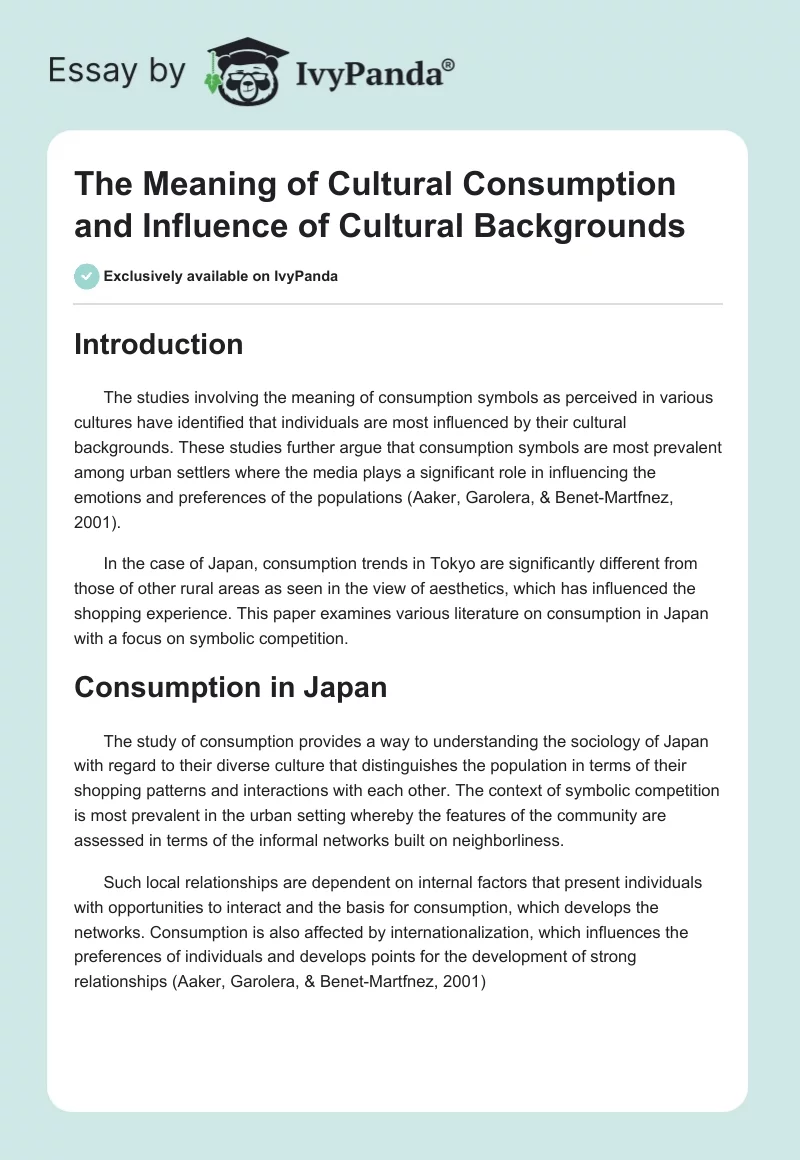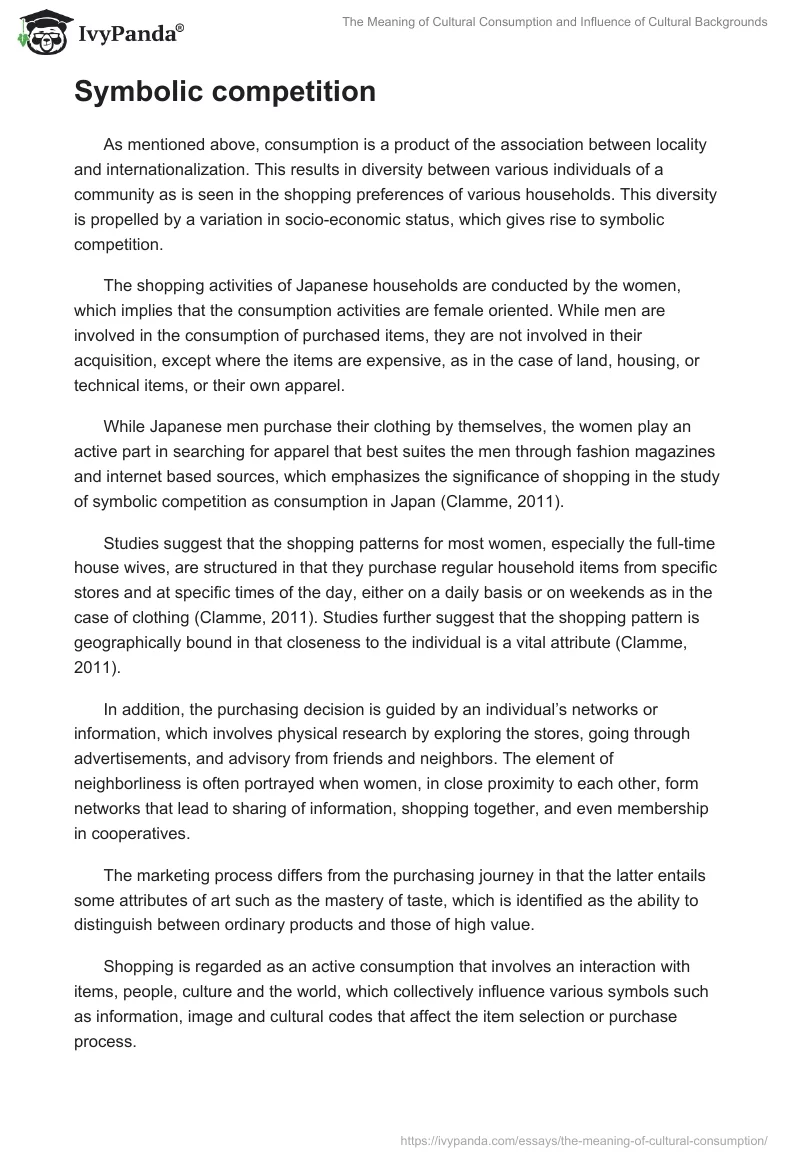Introduction
The studies involving the meaning of consumption symbols as perceived in various cultures have identified that individuals are most influenced by their cultural backgrounds. These studies further argue that consumption symbols are most prevalent among urban settlers where the media plays a significant role in influencing the emotions and preferences of the populations (Aaker, Garolera, & Benet-Martfnez, 2001).
In the case of Japan, consumption trends in Tokyo are significantly different from those of other rural areas as seen in the view of aesthetics, which has influenced the shopping experience. This paper examines various literature on consumption in Japan with a focus on symbolic competition.
Consumption in Japan
The study of consumption provides a way to understanding the sociology of Japan with regard to their diverse culture that distinguishes the population in terms of their shopping patterns and interactions with each other. The context of symbolic competition is most prevalent in the urban setting whereby the features of the community are assessed in terms of the informal networks built on neighborliness.
Such local relationships are dependent on internal factors that present individuals with opportunities to interact and the basis for consumption, which develops the networks. Consumption is also affected by internationalization, which influences the preferences of individuals and develops points for the development of strong relationships (Aaker, Garolera, & Benet-Martfnez, 2001)
Symbolic competition
As mentioned above, consumption is a product of the association between locality and internationalization. This results in diversity between various individuals of a community as is seen in the shopping preferences of various households. This diversity is propelled by a variation in socio-economic status, which gives rise to symbolic competition.
The shopping activities of Japanese households are conducted by the women, which implies that the consumption activities are female oriented. While men are involved in the consumption of purchased items, they are not involved in their acquisition, except where the items are expensive, as in the case of land, housing, or technical items, or their own apparel.
While Japanese men purchase their clothing by themselves, the women play an active part in searching for apparel that best suites the men through fashion magazines and internet based sources, which emphasizes the significance of shopping in the study of symbolic competition as consumption in Japan (Clamme, 2011).
Studies suggest that the shopping patterns for most women, especially the full-time house wives, are structured in that they purchase regular household items from specific stores and at specific times of the day, either on a daily basis or on weekends as in the case of clothing (Clamme, 2011). Studies further suggest that the shopping pattern is geographically bound in that closeness to the individual is a vital attribute (Clamme, 2011).
In addition, the purchasing decision is guided by an individual’s networks or information, which involves physical research by exploring the stores, going through advertisements, and advisory from friends and neighbors. The element of neighborliness is often portrayed when women, in close proximity to each other, form networks that lead to sharing of information, shopping together, and even membership in cooperatives.
The marketing process differs from the purchasing journey in that the latter entails some attributes of art such as the mastery of taste, which is identified as the ability to distinguish between ordinary products and those of high value.
Shopping is regarded as an active consumption that involves an interaction with items, people, culture and the world, which collectively influence various symbols such as information, image and cultural codes that affect the item selection or purchase process.
Brand names, for instance, make ideal consumption symbols since they embody a fashion that is appealing to an international market. The selection of items in consumption is governed by both the preferences and the purchasing power of the individual (Clamme, 2011).
Studies suggest that symbolic competition as an act of consumption may result in the acquisition of items driven by a variety of utilitarian factors involving “play, status, or cultural capital accumulation” (Clamme, 2011). On the other hand, a purchase may be made solely due to the desire to acquire the item for either psychological or aesthetic satisfaction.
This implies that consumer behavior is largely influenced by emotions, which in turn creates a mass culture. Symbolic competition applies to situations where some commodities are rare and available to only a specific group or class of people, especially in the consumption of foreign items.
Studies suggest that women are more prone to consumption due to their limited opportunities for social play, than men who engage in numerous after work activities such as sports, drinking and other forms of interaction away from the home (Clamme, 2011).
Conclusion
Symbolic competition arises in situations where consumption faces minimal resistance, as in the case of female shopping, which causes women to be in a constant state of material rivalry marked by class and status, as opposed to cultural competition. The destructive tendencies of this approach can be reversed by applying a Japanese context of consumption that does not bear a utilitarian description, which leads to differentiation based on class.
This is achievable because of the strong social bond among the Japanese that is provided by their culture, which would allow them to operate as a consumer society within their norms. This sense of symbolic competition would be based on cultural rivalry affected by the individual’s satisfaction of the self through possession of what is regarded as important to the self, rather than the community (Clamme, 2011).
References
Aaker, J. L., Garolera, J., & Benet-Martfnez, V. (2001). Consumption Symbols as Carriers of Culture: A Study of Japanese and Spanish Brand Personality Constructs. Journal of Personality and Social Psychology, 18(3),492—508.
Clamme, J. (2011). Contemporary Urban Japan: A Sociology of Consumption. River Street Hoboken NJ: John Wiley & Sons.


